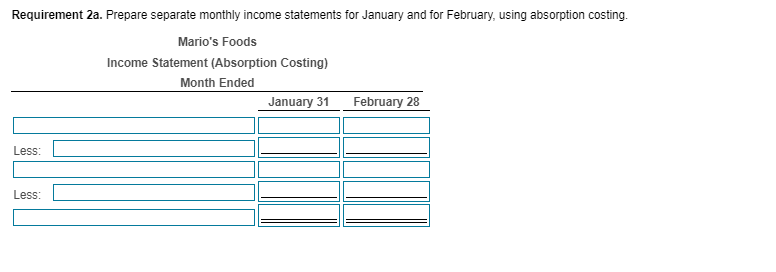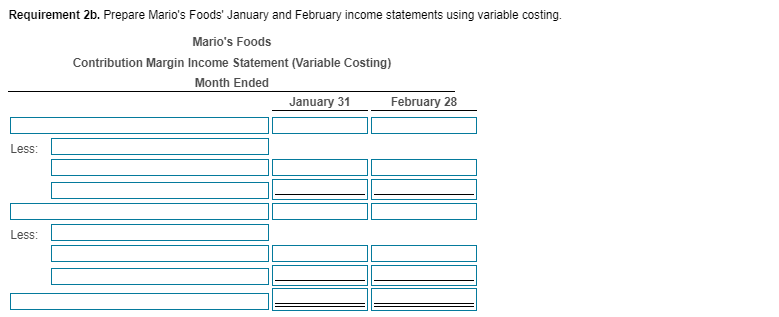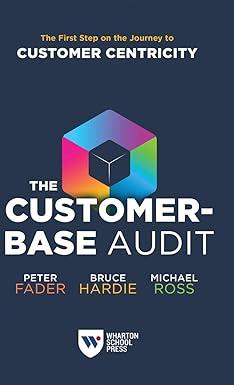Question
Options for Fill in the Blanks: 1: Equals, Exceeds, or is less than 2: Equals, Exceeds, or is less than 3: January's, February's 4: Fixed





Options for Fill in the Blanks:
1: "Equals", "Exceeds", or "is less than"
2: "Equals", "Exceeds", or "is less than"
3: "January's", "February's"
4: "Fixed Manufacturing Overhead", "Non-Manufacturing", or "Variable manufacturing overhead"
5: "Capitalized", "Expensed", or "Paid for in cash"
6: "Fixed Manufacturing Overhead", "Non-Manufacturing", or "Variable manufacturing overhead"
7: "Increases", or "Decreases"
8: "Equals", "Exceeds", or "is less than"
9: "Equal to", "Greater Than", or "Less than"
10: "Increases", or "Decreases"
11: "Fixed Manufacturing Overhead", "Non-Manufacturing", or "Variable manufacturing overhead"
12: "January", or "February"
13: "Increases", or "Decreases"
Data Table January 1,400 meals 2,000 meals February 1,800 meals 1,600 meals Sales Production Variable manufacturing expense per meal Sales commission expense per meal Total fixed manufacturing overhead Total fixed marketing and administrative expenses S 800 S 700 S 800 S 700 Print Done Mano's Foods produces frozen meals, which it sells for $9 each. The company uses the FIFO nventory costing method and it computes a new monthly fixed manufac uring overhead rate based on the actual number of meals produced that month. All costs and production levels are exactly as planned. The following data are from the company's first two months in business: EEB Click the icon to view the data.) Requirements 1. Compute the product cost per meal produced under absorption costing and der variable costing. Do this first for January and then for February. 2. Prepare separate monthly income statements for January and for February, using the following: a. Absorption costing b. Variable costing 3. Is operating income higher under absorption costing or variable costing in January? In February? Explain the pattern of differences in operating income based on absorption costing versus variable costing Requirement 1. Compute the product cost per meal produced under absorption costing and under variable costing. Do this first for January and then for February. January February Absorption Variable costing Absorption Variable costing costing costing Total product cost Requirement 2a. Prepare separate monthly income statements for January and for February, using absorption costing Mario's Foods Income Statement (Absorption Costing) Month Ended January 31 February 28 Less: Less:[ Requirement 2b. Prepare Mario's Foods' January and February income statements using variable costing. Mario's Foods Contribution Margin Income Statement (Variable Costing) Month Ended January 31 February 28 Less: Less: Requirement 3. Is operating income higher under absorption costing or variable costing in January? In February? Explain the pattern of differences in operating income based on absorption costing versus variable costing. In January, absorption costing operating income 1 Absorption costing defers some of 3 sold. Deferring these6 In February, absorption costing operating income 8 As inventory 10 ,as was the case in this February, January's units sold. Y variable costing income. This is because units produced were 2 unti those units ane Y costs in the units of ending inventory. These costs will not be 5 until those units are costs to the future January's absorption costing income V variable costing operating income. This is because units produced were9 Vunits sold for the month 11 costs that absorption costing assigned to that inventory are expensed in V. This13 February's absorption costing incomeStep by Step Solution
There are 3 Steps involved in it
Step: 1

Get Instant Access to Expert-Tailored Solutions
See step-by-step solutions with expert insights and AI powered tools for academic success
Step: 2

Step: 3

Ace Your Homework with AI
Get the answers you need in no time with our AI-driven, step-by-step assistance
Get Started


